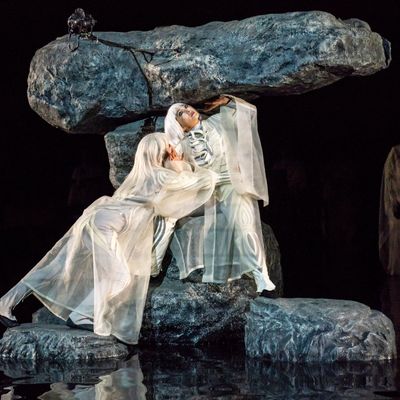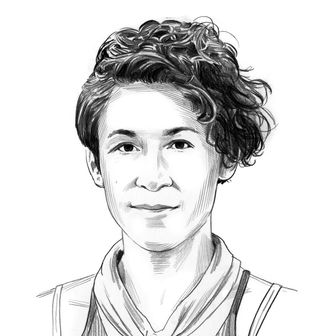
Satoshi Miyagi’s grand, mesmerizing Antigone is not a tragedy. It seems like it might have been more of one when the director first tackled the 2,500-year-old play back in 2004. But by the time Miyagi brought a new version, reenvisioned with the Shizuoka Performing Arts Center, to the Avignon Festival in 2017, the ancient Greek drama had become a Buddhist ritual, an expansive tribute to the spirits of the dead, visually and musically gorgeous and released from any Western notions of the dramatic power of emotional angst.
That’s the Antigone that’s currently taking place in an 18,000-gallon pool of water at the Park Avenue Armory. “The idea that there is water between the land of the living and the land of the dead is an image shared by both Japan and Ancient Greece,” writes Miyagi in a program note. “We have this idea of a border separating two things being defined by water … [And] the polytheistic way of thinking in pre-Christian Greece is actually something very familiar to us in Japan. So we don’t feel that doing Antigone is importing something from Western culture, but something that we can touch quite directly.”
There’s no way I can speak from anything but gut instinct when it comes to exactly how the more than two-millennia-old plays of Sophocles might actually have felt to an audience first experiencing them in the theater, but Miyagi’s staging of Antigone — though it’s Japanese in every way — strikes me as embodying something fundamental at the heart of these ancient Mediterranean texts. Perhaps they’re not, as so many post-Stanislavski Western stagings have tried to convince us, treacherous psychological peaks to be scaled with an excess of howling, breast-beating, and garment-rending. Perhaps they’re not really psychological — at least in our Strasberg-and-Brando sense of the word — at all. They were always rituals: massive and sacred communal rites performed by actors in masks, physically stylized, distant, and, in the original sense, awesome — the very concept of catharsis essentially a religious one, a kind of shared public cleansing. Miyagi’s Antigone is not a story about the living; it’s a rite for the dead and an acknowledgement of the thinness of the veil that separates the two. As such, without ever seeking to stir up the earthly passions of its audience, it is deeply, existentially moving.
Not that it’s wholly, heart-poundingly compelling in every moment: Miyagi has crafted his play around a limited number of big gestures — the enormous wading pool with its jutting, rock-garden-like islands; the ethereal white robes and skeletal white bodysuits on all his actors (the ghostly garments are by Kayo Takahashi); the bunraku-inspired separation of characters into a speaking actor and a silent, moving actor — and in between these macro choices there aren’t always a plethora of micro choices. You’ve got to settle into the show’s rhythm, let your heartbeat slow down and your Aristotelian expectations soften. It can be difficult, as an American theatergoer, to let go of plot and character as the central engines for a story. But, at least to my limited understanding, Buddhism is partly about learning to release your grasp on the things of the world. And when you open your hands and allow yourself to float in Miyagi’s production, the experience is hypnotic.
In a way, Miyagi’s company forces the audience out of a conventional Western relationship with plot right away: As we enter the theater and take our places, we watch the actors slowing moving through the huge, dark pool, their translucent white robes dragging in the water. They carry candles inside of singing bowls that they play softly. The cavernous space is all shadow and hush, with just the flicker of tiny lights, the lap of water and the shimmering buzz of those simple instruments. Then the trance is broken by a procession of actors who march around the pool’s periphery, beating time on various pieces of percussion. “Good evening, ladies and gentlemen!” one of them shouts in English, a huge smile on her face. (“English,” she’ll inform us in a few moments, “is a very difficult language, so we will need your support” — at least for the extent of the prologue; the show itself is in Japanese with English subtitles.) In a bouncy, near-cartoonish vein, she and her fellow actors play out an abbreviated summary of Antigone for us — “In case you’ve forgotten the story!” she beams. The tonal 180 from the murky, meditative preshow is so jarring that it made me giggle — but then I decided I dug it. Here were the traveling players, doing an almost comedic preshow summary of their verse tragedy in Hamlet. There’s something unembarrassed and essential about the theatricality of Miyagi’s preshow: It refuses to take itself too seriously. It’s town-square stuff, not fancy opera-house stuff, and it’s exciting to see a director trust in an audience’s ability to shift quickly between styles — to follow his actors from burlesque to bunraku, surrendering to the quicksilver spirit of play.
After the prologue, once we’ve launched into the story about the young woman who buries her brother in defiance of a king’s edict, all smiles are gone, but they aren’t replaced with grimaces and weeping. The emotional arc of the show belongs to the sweeping, gorgeous ebb and flow of composer Hiroko Tanakawa’s original music (performed on an array of instruments spread out along the backside of the pool by Miyagi’s multitalented cast), while the actors themselves function more like priests or shamans, somehow tranquil even in their evocation of defiance and disaster. Micari, the single-named performer who physically represents Antigone, spends the majority of the show aloft on the central stack of rocks rising from the set’s great pool. Her speaker, Maki Honda, kneels in the water and intones for her while she stretches and bends on her precarious perch — it’s a prison, but one she’s chosen — her enormous shadow thrown against the Armory’s back wall. Though Honda’s voice soars and dips, neither actor registers conventional emotion on her face. Sometimes, Micari turns her back to us for long passages, so that her looming shadow is the most expressive of the three Antigones Miyagi has created. Antigone’s betrothed, the idealistic, doomed young prince Haemon (speaker, Daisuke Wakana; mover, Yoneji Ouchi) never touches his beloved — they’re trapped on separate islands, separated by yards of water, but their shadows mingle and merge on the wall behind.
The beauty of Miyagi’s Antigone is that it seeks an image vocabulary for death that allows for dispassionate but not unkind reflection upon the living. Late in the play, when the stubborn king Creon receives tragic news, his speaker, Kazunori Abe, lets out two wracked, prolonged screams, while his mover, Kouichi Ohtaka, goes weak at the knees and reaches skyward, his face all stone. It’s a marvelous moment. We aren’t being asked to feel Creon’s pain. We’re being shown how strange, how distant, how loud and yet how small human suffering must look to the gods, or to the dead.
Antigone is at the Park Avenue Armory through October 6.





